Now Reading: Agile Retrospective: Financial Service Case Study
-
01
Agile Retrospective: Financial Service Case Study
Agile Retrospective: Financial Service Case Study
How a Global Enterprise Aligned Remote Teams and Overcame Sprint Bottlenecks

The Challenge: Distributed Teams, Disconnected Processes
GlobalCorp’s agile transformation was hampered by its distributed nature. Teams in different time zones rarely interacted directly, leading to misunderstandings and redundant work. Retrospectives were conducted in silos, and valuable insights from one team were never shared with others. Critical dependencies between teams were often discovered late in the sprint, causing significant delays.
The Process: Centralized Planning for a Global Team
- Step 1: Prepare for Retrospective: The Agile Coach established a template in the planner for all teams. Scrum Masters would start here, linking cross-team dependency reports and allowing team members to add comments asynchronously before the meeting.
- Step 2: Conduct the Retrospective: The meeting agenda was pre-defined in the planner, making the live session highly efficient. Teams focused on discussing the pre-populated data points rather than starting from scratch.
- Step 3: Analyze & Prioritize: For a ‘Scrum of Scrums’ retrospective, the coach used the planner to map out an ‘Affinity Mapping’ session, grouping systemic problems identified from individual team reports.
- Step 4: Implement & Monitor: Enterprise-level improvement initiatives were created in the ‘Task Plan’, with owners from different teams to foster cross-functional collaboration and accountability.
- Step 5: Get Final Report: Each team’s final report was exported and linked in a central repository. This created a unified view of organizational challenges and progress, which was invaluable for leadership.
The Results: Alignment, Transparency, and Efficiency
By standardizing on the planner, GlobalCorp achieved over 90% consistency in their retrospective process. The shareable reports drastically improved transparency, leading to a 50% reduction in recurring cross-team blockers within six months.
The structured planning process also reduced the time spent organizing retrospectives by 30%, freeing up Scrum Masters to focus on more value-added coaching activities.

